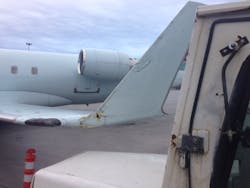Aircraft ground damage is expensive and compromises the safety of crews and passengers on the apron, it is such a significant issue that it sits very high in the agenda of aviation executives; it is also being addressed by a variety of industry programmes and working groups.
Yet there is something even more subtle than aircraft damage itself and this is unreported damage. Undetected structural damage, at its worst, can carry very serious damaging potential. Although it is quite accurate to state that it is more often minor damage to go unreported – i.e. dents or scuffs on the fuselage – this type of damage should not be there in the first place and should always be reported, especially now with the increasing use of composites.
Maintenance managers are perhaps the most vocal to complain about unreported damage because it falls into the maintenance budget, whereas instead these repairs should be invoiced to the cost centres of the entities actually causing the damage. Airlines appear to have historically treated these minor – unreported – events as a normal cost of doing business, but things are now changing.
With the implementation of safety management systems (SMS) even in the domain of aircraft ground handling, the reporting sensitivity of personnel is increasing. Hopefully the industry will mature to the point that operators will be able to actually define accurate statistics on the incidence of ground damage and to better appreciate and manage the associated costs.
The theory behind SMS is that accidents and other serious safety events are only the tip of the iceberg; there is an exponential relationship between major events and minor events manifesting or carrying some damaging potential. Latent conditions are those organisational processes with the potential of causing a loss in a particularly unfavourable combination of circumstances. Time pressure and the likes of an untrained employee performing ground handling services can be considered as latent conditions or precursors to damage events occurring on the apron. A ground damage event does not directly harm the safety of flight because it should be detected and reported. Unreported damage, however, may affect the safety of flight. It is important to reiterate that it is normally minor damage that goes unreported; the issue of under-reporting should not be treated light-heartedly, as undetected damage is both an accident outcome and a latent condition. Undetected damage means that an organisation is failing both in the prevention of events and in the implementation of recovery measures after a safety event has been caused.
Found/reported ratio
To define an approximate reported/found ratio of aircraft damage events can be a very difficult exercise for airlines. Canadian operator Jazz Aviation since 2013 has had a total of 224 reported damage events; 61 of these have been classified as of ‘unknown’ origin. This is 27 percent of all reported damage; but as to how much is repaired, the airline does not have a picture of how much repaired damage went unreported, say Brent Boden and Geraldine Hamilton from the safety management department of Jazz Aviation.
A similar challenge is encountered also by British carrier Easyjet. “We find it very difficult to compare our reporting rates to other airlines and handlers due to the many different reporting descriptors across the different safety management systems employed in the industry,” says David Cross, ground operations quality and safety manager at Easyjet. "This figure also varies as to which department takes accountability for ground damage. At EasyJet we have an improved reporting rate as we actively encourage an open reporting culture."
The fact that there is an improving reporting trend is also confirmed by Qatar Airways: “We have reversed the trend over the last two years. From approximately a 60/40 found/reported ratio our current ratio is 10/90,” says Mark Corbett, manager of ground safety at Qatar Airways.
Incentives to report
There needs to be some reasons why aircraft damage events can and often go unreported when they occur. One of the possible reasons is that line employees are not given enough incentives to report.
“The main reason for under-reporting we have found is the non-application of ‘just culture’ principles. Companies, even in the UK, still employ a ‘shoot first, ask questions later’ policy with ground damage incidents. Until all ground agents feel that a fully developed ‘just culture’ philosophy is in place then there will always be a fear factor to reporting incidents,” says Cross.
Improving ground damage reporting figures can be indeed derived from the strengthening of the ‘just culture’ movement in the ground operations domain of the international airline industry. According to Corbett Qatar Airways’ positive figures in terms of a considerably improved found/reported aircraft damage ratio is because the airline has actively been promoting non punitive reporting for the greater benefit.
This view is shared by Boden and Hamilton who affirm that Jazz Aviation has an SMS which “includes a non-punitive reporting policy so if damage is not reported and we discover who did it, it can be punitive; however we seldom do as we choose to take the high road to encourage further reporting.” According to Boden and Hamilton there must be a way to better define the just culture ideal of not including discipline even if an employee did not report the event: “this is a critical step because even if the safety reporting policy does not protect the employee (due to their disregard for safety report), there is great impact when an employee is found to be guilty of causing the event without reporting it, yet they are not disciplined. For example, if an employee damages and aircraft and the event is not reported due to their embarrassment or fear of persecution and discipline, the company has a great opportunity here to teach the employees the benefit of cooperating with the investigation even if not reported. If a person is disciplined because they did not report the event, from a legal perspective the company should not explain to the rest of the workforce why that person was disciplined. Because of this there is misinformation within the workforce that the fellow was disciplined after a damage event.
“Without being able to tell the workforce the entire truth of what happened with this individual, the misinformation within the workforce will be extremely detrimental to the reporting culture and the safety level on the ramp and of course the destruction of the just culture we all should wish to provide,” say Boden and Hamilton.
Awareness on damage causation
Another possible reason of the under reporting of aircraft damage events is that employees are not aware of causing damage, although this is rare. “I personally do not believe that under-reporting is a result of lack of awareness to damage caused as this is part of training right from the outset for all ground agents. Constant reminders on the importance of reporting all ground damage incidents are also in place,” says Cross.
Boden and Hamilton have a similar view: “It is hard to believe that someone damaged a vehicle or aircraft and did not know they did it. However, we are sure it could happen, such as in the case of a static wick being knocked off.”
Corbett recognizes the potential for non-deliberate non-reporting of aircraft damage events and stresses a need for “increased awareness of potential damage especially with the introduction of composites, which have the peculiar property of not denting in case of collision so any slight touch needs to be reported for inspection”.
Was the damage pre-existing or was it not?
The inability to ascertain whether a given damage is or is not pre-existing is indeed associated to the non-reporting of aircraft damage events. The same factor compounds the difficulty in tracking accurate figures of the incidence of aircraft ground damage as well as the found/reported ratio.
One solution in this respect is the use of stickers, but these sometimes can fall off and damage gets reported again, say Boden and Hamilton who also add that at Jazz all damages are tracked using bingo stickers.
The issue is also recognized by Corbett who says that “determining old damage from new damage is difficult as most carriers do not like stickers of kinds placed against paint to identify damages by dates."
Improve reporting sensitivity
So, what can ground handling companies do to improve the current status of things? What can be done to improve the reporting sensitivity of personnel? In this regard Corbett further underlines how the promotion of non-punitive reporting has considerably helped Qatar Airways to improve the found/reported ratio.
Boden and Hamilton highlight that other incentives such as contests may help. However, contests have the downside that safety departments may end up having a hard time to keep up with investigating the reports received. Jazz Aviation receives over 550 reports per month, these include ground safety, air safety and occupational health and safety reports, say Boden and Hamilton.
Improved damage detection
More thorough damage detection is another strategy which can support an improvement in the found/reported damage ratio. The walk-around is that part of operations which can best supply a well-defined layer of control in damage tracking, on top of course of releasing airworthy aircraft.
According to Boden and Hamilton, operators should “do a blitz on walk-arounds with pilots, ground and maintenance personnel to ensure they are detailed enough and complied with.”
Corbett encourages them to “constantly ‘walk the patch’ and encourage people to be open. We have also produced a series of safety promotional videos by Senior Management including the Accountable Manager and ramp safety turnaround videos to be constantly displayed via intranet and at staff break areas to enhance the safety awareness.”
Generating efficiencies
According to Cross efficiencies in reporting can be increased through active encouragement and the application of the concept of ‘just culture’. Cross however also stresses that further opportunities exist in equipment design. “The International Air Transport Association (IATA) is currently exploring ways to develop requirements for ground service equipment (GSE) design and increase safety standards. In today’s world it is possible to buy a budget car that will park itself and warn of any impending impact but GSE design has not changed for more than 30 years. The use of GSE ‘black boxes’ will also aid investigations to bring to light systematic failures and areas worthy of procedural improvements. Telematics have been available to the general public for a number of years for automobiles and these systems should be simple enough and transferable to airport equipment. This would also offer cost savings with the ability to track equipment and reduce levels of equipment currently being utilised on airport ramp areas,” says Cross.
In relation to GSE design IATA’s Ground Support Equipment and Environmental Management (GSEE) task force comprises technical experts from ground service providers, airlines, GSE manufacturers and aircraft manufacturers. According to the association’s website, the task force focuses on the technical, functional and safety aspects of GSE as well as the impact GSE has on the environment. The task force continually reviews and develops the policies, strategies and guidelines as published in the IATA Airport Handling Manual (AHM) in the following areas: technical standards and specifications for all types of GSE, the interfaces between aircraft and GSE, aircraft and GSE design modifications to address ground operations needs and environmental guidelines for ramp operations, the website notes.
In relation to generating efficiencies from more consistent reporting and improved damage detection, Corbett highlights how benefits can be derived which go beyond the direct costs of repairs: “Actual repair costs are minimal compared to the consequential costs in terms of brand/image protection, customer retention, social media bad press, etc.”
According to Boden and Hamilton in order to generate large scale efficiencies it is important to involve all stakeholders in the process: “We can report more, but no financial benefit will be found unless we do a better job of gathering all the costs and improve contracts so the providers are held accountable to the cost, however this may decrease reporting as it increases the providers’ costs and they cannot afford to do the work. Some of the ground providers are small companies that could never survive with bills for major repairs.”
Maturing SMS
Scheduled international airlines, after several years of implementation, now have effective SMS in place. Because of the airlines’ leadership of the aviation industry, advances in SMS implementation are also being made by ground handling companies, with the recently turned mandatory character of SMS requirements within ISAGO marking a significant commitment from ground handling companies.
In order to have effective SMS in place, ground handling companies need to develop on the ground the cultural dynamics sustaining reporting that peculiarly characterise the flight operations’ side of the airline business. With the solid adoption in the cockpits of crew resource management, lower ranking crew members have the opportunity to speak up for the sake of operational safety and internally report hazardous events. This has not always been the case and it has taken a long time to develop.
Implementing an SMS cannot be a bureaucratic exercise; it needs commitment and a culture that sustains it. This can only happen so long as employees are empowered to feel they ‘own’ their job, are valued for their contribution and supported when they report the errors they make in good faith.
Mario Pierobon is a safety management consultant and content producer. He regularly writes about aviation safety and he is currently involved in a ground handling safety project at Cranfield University in the UK. He may be reached at [email protected].






